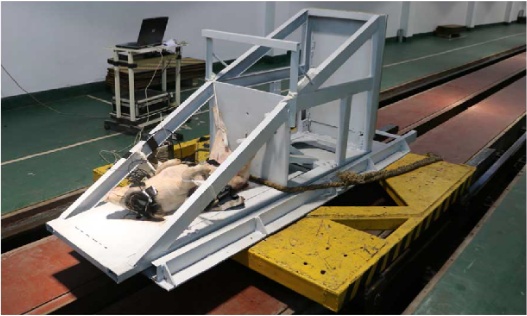
A journal has issued an expression of concern over a 2018 paper which involved strapping 21 anesthetized minipigs to sleds and running them into a wall at speeds of up to 25 miles per hour.
The study, “Experimental study of thoracoabdominal injuries suffered from caudocephalad impacts using pigs,” came from the Third Military Medical University in Chongqing, China, and was funded by the People’s Liberation Army.
About those impacts. The purpose of the study, according to the abstract, was this:
The injuries induced by caudocephalad impacts (CCI) frequently occurred in military vehicles, for example, underbelly blasts (UBB), which have led to large numbers of injuries and deaths [1–3]. Some civilian accidents, such as helicopter crashes and falls [4–11], resulted in also so many casualties owing to the CCI. …
In order to more clearly address the thoracoabdomen CCI-induced injuries, adult minipigs, whose anatomical structures of thoracoabdominal organs and physiological changes of the impact injury are similar to human body to some extent [23], were employed as a surrogate model of human body in the present study.
How were the minipigs “employed”?
When the experiment was initiated, the sled was accelerated from the starting position, running along the rail with a length of about 80.0 m, and stopped by the contact between the thin-wall pipes and rigid wall. The impact velocity of the sled was determined with a customer speed dosimeter. The whole course of the CCI was recorded by a high-speed video camera (Phantom V4.3, Vision Research), at 1000 frames per second.
Not surprisingly, given the nature of the testing:
The common thoracoabdomen injuries from the autopsies included fractures, contusion, laceration, bleeding, and hemorrhage. The injured thoracoabdominal organs, that is, the spleen, lung, heart, and kidney, were observed commonly …
In other words, the trauma basically turned the animals’ insides to pulp.
The researchers conclude that their findings:
may be useful in forensic science, emergency management, and injury prevention.
Here is the expression of concern:
Applied Bionics and Biomechanics would like to express concern with the article titled “Experimental Study of Thoracoabdominal Injuries Suffered from Caudocephalad Impacts Using Pigs” [1].
Concerns have been raised regarding the ethical standards of the reported research, which we feel require further investigation. These investigations will aim to determine whether the research adheres to the recommendations of the Guide for the Care and Use of Laboratory Animals of the National Institutes of Health, as stated in the manuscript.
The authors have been informed of this notice and the on-going investigation.
The authors have not responded to our requests for comment.
Matt Hodgkinson, head of research integrity for Hindawi, told us:
We are following up with the authors and seeking expert advice on the conduct of and motivation for these experiments. When concerns are identified post-publication, we raise this with the editor to help their future editorial handling. While editors and reviewers can raise concerns about research ethics during peer review, this is less likely when researchers have received formal ethical approval, report adhering to international guidelines, and report the use of anesthetic, and pigs are often used in research as a model for traumatic injury.
Like Retraction Watch? You can make a tax-deductible contribution to support our work, follow us on Twitter, like us on Facebook, add us to your RSS reader, or subscribe to our daily digest. If you find a retraction that’s not in our database, you can let us know here. For comments or feedback, email us at [email protected].
I seem to remember we were conducting similar experiments in the UK decades ago. Justified on the grounds of reducing road traffic accidents and their consequences by producing better seatbelts. Sometimes anesthetic was used – sometimes not.
Then I believe we used human cadavers that had been donated for medical research.
I imagine the military budget is huge and experiments can be constructed to take advantage of such.
Needless to say, I personally find it all totally dishonourable and without merit but I thank you for publising and thus alerting us.
It is not clear to me why ethical concerns were not raised by the reviewers or editors of the journal when the manuscript was peer reviewed?
As an animal welfare scientist and lab animal technician my questions are 1: were they in proper surgical anaesthesia during the experiment? and 2: were they allowed to regain consciousness? If the answers to those questions are “yes” and “no” respectively, then the pigs didn’t suffer as a consequence as the experiment.
There would still be a question of ethics and whether the research has merit, but not of animal welfare. That’s not at all is unique to this experiment though.
All that potential suffering for publication in a journal with an impact factor (no pun intended) of just over 1.5…
The paragraph “ The common thoracoabdomen injuries from the autopsies included fractures, contusion, laceration, bleeding, and hemorrhage. The injured thoracoabdominal organs, that is, the spleen, lung, heart, and kidney, were observed commonly …” appears to be a quote from the paper but is not indented as a quote.
Fixed, thanks!